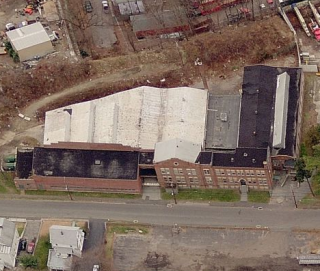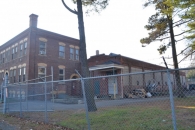Mill Record Norwalk
RETURN TO ‘FIND MILLS’Disclaimer: Content for these properties was compiled in 2014-2017 from a variety of sources and is subject to change. Updates are occasionally made under Property Information, however the Connecticut Trust for Historic Preservation (dba Preservation Connecticut) makes no representation or warranty that the information is complete or up-to-date.
- Complex Name (Common)
- J. & J. Cash Ltd.
- Complex Name (Historic)
-
- J. & J. Cash Ltd.
- Address or Location
- 57 Chestnut Street, South Norwalk, Norwalk
- County
- Fairfield
- Historic Designation
- Associated Mill Community
- n/a

- Historic Information
Companies Associated w/Complex
- J. & J. Cash, Ltd. 1906-1919
- J. and J. Cash Co., Inc. 1919-Late-20th c.
Use (Historic)
Largest Documented Workforce
100-199 (1939).
Historic Narrative
The textile manufacturer J. and J. Cash, Ltd. was originally established by brothers John and Joseph Cash in Coventry, United Kingdom in 1846. The firm specialized in the manufacture of silk ribbon, however, the Cash brothers soon became equally notable for their efforts to reshape the overwhelmingly cottage-based industry after they built a village of 100 houses with weaving workshops on their upper floors in an effort to centralize their workforce and production. Although the Cash brothers were widely criticized for this experiment as many thought it coddled the working class, the result was a productive workforce and a thriving business. The Cash brothers’ willingness to take risks again manifested during the 1870s when the firm began producing colored embroidery work. This in turn led to the production of embroidered name tapes for clothing, which became the core of the company’s business by the turn of the century. The success of J. and J. Cash, Ltd.’s name tape business soon led to the decision to establish a production facility in the United States. A site was secured in South Norwalk, Connecticut in 1905 and work on the new factory was completed in October 1906. At the time of the building’s completion, executives at J. and J. Cash felt that the size of the new Norwalk plant would suffice for at least 20 years of growth, however, a substantial addition was needed by 1912. It was at this point in time that the manufacture of woven clothing labels was added to the firm’s catalog, a move that would drive the need for further additions to the factory during the 1920s. In 1919, executives at J. and J. Cash made the decision to separate the American branch from the parent firm. J. and J. Cash, Inc. was organized with $300,000 in capital, and this business soon expanded production with additional factories in Ontario, Canada and Los Angeles, California. Further additions to the Norwalk plant were completed in 1922 and 1926, and new sales offices were established in New York, New York; Chicago, Illinois; San Francisco, California; Santiago, Cuba by 1930. By the late-1930s, the American branch was valued at over $1 million and the Norwalk facility employed between 100 and 200 hands. J. and J. Cash, Inc. remained in business in Norwalk through the late-1970s, yet had closed its doors by the late 1980s. For additional historical information on the company started in Coventry, UK, and its many products, see website on J & J Cash Ltd curated by Pete Cave: https://wovenstuff.weebly.com/
- Architectural Information
Number of Existing Buildings
Roughly nine (9) adjoining primary blocks.
Dates of Construction
1905, 1912, 1922, 1926, ca. 1940, ca. 1955, ca. 1960, ca. 1970, ca. 1980.
Architect
n/a
Builder
n/a
Building Type
Architectural Description
The former J. and J. Cash, Ltd plant is comprised of nine primary adjoining blocks located on the west side of Chestnut Street, roughly 100’ south of Chestnut Street’s intersection with Merritt Street. The oldest and original portion of the factory was erected between 1905 and 1906 and consists of two red brick blocks located near the northern end of the complex. These include a two-and-a-half-story, 60’ x 35’ office building that fronts on Chestnut Street, and a one-story, 35’ x 136’ weave shed that adjoins the office block’s west (rear) elevation. The office’s exterior is highly detailed and has a raised brick basement level, segmental-arched window openings with glazed buff brick lintels and stone sills, one-over-one double-hung wood windows, a corbelled and denticulated brick cornice, flat roof, and a corbelled brick chimney. The primary entrance to the factory is centered on the office’s five-bay façade and is accessed by a red brick and stone stair flanked by cast iron newel posts and radial iron balusters. The entry is set within a round-arched opening with a glazed buff brick lintel, stone keystones, and a stone sill. A pair of wood and glass paneled doors topped by a solid transom bearing a painted number “57” leads into the building. Compared to the office, the design of the weave shed is much more utilitarian. It is of brick pier construction and has a front-facing gable roof. A one-story, 26’ x 140’ red brick addition was erected adjoining the weave shed’s north elevation ca. 1922. This is of brick pier construction and has large rectangular window openings (most later reduced in size through the addition of concrete block infill), a stepped brick parapet, concrete coping, and a flat roof with one nearly full-length sawtooth monitor. A single loading bay is located on the façade (east elevation). This has a metal roll-up style door and a hipped roof porch. A substantial addition to the plant was erected adjoining the office’s south elevation in 1912. This consisted of a second two-and-a-half-story office block, and another one-story weave shed. Both blocks are of red brick construction and they largely mimic the respective details of the original plant. One primary difference, however, is that the 1912 office has a prominent stepped brick parapet with concrete coping and a round gable-end window set in a glazed buff brick opening. The office measures roughly 50’ x 35’, while the weave shed measures 50’ x 100’. An open area between the two weave sheds was infilled through the construction of a one-story, 36’ x 95’ block ca. 1980. Additional factory space was added in 1926 and ca. 1940 when a one-and-a-half-story red brick block was erected – and then enlarged – at the southern end of the plant. This is of brick pier construction and has large rectangular window openings, a flat roof, and three sawtooth monitors. The combined building measures roughly 105’ x 98’ and was joined with the northern portions of the plant through the construction of a one-and-a-half-story, 25’ x 98’ addition ca. 1960. The final additions to the plant were completed at the southeast corner of the property ca. 1955 and ca. 1970. These consist of a one-story, 18’ x 50’ storage building, and a one-and-a-half-story, 115’ x 46’ manufacturing block, respectively. Both are of concrete block construction and have concrete foundations, red brick apron walls, concrete coping, and flat roofs. The manufacturing building is notable for a nearly full-length ribbon window extending along its façade (east elevation).
Exterior Material(s)
Structural System(s)
Roof Form
Roof Material
Power Source
Condition
Fair
Condition Notes
The complex is in fair condition. Although the majority of the exterior walls and windows are in need of cleaning and maintenance, the plant appears to be generally well maintained and structurally sound.
- Property Information
-
Specific Location
One legal parcel (57 Chestnut Street) totaling 1.74 acres located on the west side of Chestnut Street, roughly 100’ south of Chestnut Street’s intersection with Merritt Street.
Adjacent To
n/a
Exterior Visible from Public Road?
Yes
Parcel ID / Assessor Record Link
- 2/76/27/0. / Link →
Acreage
1.74
Use (Present)
- Sources
-
Form Completed By
Lucas A. Karmazinas
Date
11/06/2015
Bibliography
- List of Connecticut Manufacturers, 1922, 1924, 1930, 1932.
- Directory of Connecticut State Manufacturers, 1936, 1939.
- Industrial Directory of Connecticut, 1947.
- Register of War Production Facilities in Connecticut, 1951.
- Map of New Haven County; Clark, Richard, 1859.
- Atlas of New Haven County, Beers, Ellis & Soule, 1868.
- Aerial Survey of Connecticut, 1934, 1951, 1965, 1970, 1985.
- Sanborn Map Company, 1891, 1896, 1901, 1906, 1922, 1950, 1958.
- Norwalk Directory; Various editions.
- Hartford Courant, 1930.
- Norwalk after Two-hundred & Fifty Years; Norwalk Historical and Memorial Library Assoc., 1901.
- Norwalk; Grant, Lisa Wilson, 2014.
- Representative View(s)Click on image to view full file








